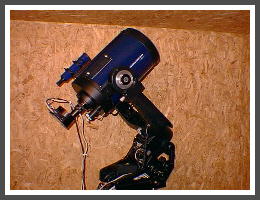Self Guiding While Imaging

Precise guiding while taking an image is a CCD imagers dream come true. Manual guding for long durations in sometimes cold conditions is now eliminated!. Let the ST7 do the work...
Enter the 'track' menu and select 'self guide' (assuming all previous procedures have been completed). Enter the exposure time for the oject you wish to image, then enter the number of seconds the tracking chip is to take an exposure, usually around 2-5 seconds. Long tracking times will cause large corrections if the drives are not consistent and/or the polar alignment is off slightly. I use 2 or 3 second tracking exposures to keep the amount of drive induced drift to a minimum.
If the telescope is properly polar aligned there should be very little DEC corrections. Where most guiding corrections occur is in the RA drive. The LX200 drives are very accurate for visual observing but when sub-pixel guiding requirements are necessary, the drives must be corrected. When self guiding has started, the software will display the errors in RA and DEC as they occur. Attempt to achieve no more than 1.0 pixel errors when self guiding. If they are 1.0 or more the image will show egg shaped stars especially in long duration integrations. The goal is to have pinpoint round star images. A correctly calibrated and setup telescope and camera can average less than .5 pixel correction errors. If the corrections are averaging < .5 pixels and the drive makes a large correction such as 1.19 and returns back to the average, it most likely due to scintillation (atmospheric light defraction from the star).
The table below represents a sequence of errors during 10 corrections. Column A represents an acceptable error rate, B represents drives that are being over-corrected, and C
represents drives that are being under-corrected:
Drive Correction Example Table
| | A | B | C |
|---|
| Correction Sequence | RA-----DEC | RA-----DEC | RA--------DEC |
|---|
| 1 | +0.11 ~ +0.22 | +0.23 ~ -0.22 | +0.23 ~ -0.13 |
|---|
| 2 | +0.23 ~ -0.21 | -1.04 ~ +0.88 | +0.34 ~ -0.22 |
|---|
| 3 | +0.15 ~ -0.02 | +0.34 ~ -1.22 | +0.39 ~ -0.44 |
|---|
| 4 | -0.12 ~ +0.19 | -0.67 ~ +0.12 | +0.55 ~ -0.69 |
|---|
| 5 | +0.33 ~ -0.16 | +0.84 ~ -0.81 | +0.82 ~ -0.77 |
|---|
| 6 | +0.03 ~ +0.24 | -0.66 ~ +0.98 | +1.33 ~ -0.81 |
|---|
| 7 | -0.54 ~ -0.33 | +1.13 ~ -0.97 | +1.59 ~ -1.13 |
|---|
| 8 | -0.05 ~ +0.04 | -0.88 ~ +0.67 | +1.88 ~ -2.01 |
|---|
| 9 | +0.29 ~ +0.23 | +1.43 ~ -0.24 | +2.66 ~ 2.99 |
|---|
| 10 | -0.10 ~ -0.06 | -0.59 ~ +1.54 | +3.23 ~ 3.55 |
|---|
| | | |
|---|
| | | |
|---|
To fully understand what is going on in the above table, one has to know how to read the errors and what pattern they follow. Consider the best guiding conditions: errors are 0.00 for RA and DEC. We know that this is not possible even with the most sophisticated drives. Atmospheric distortion (refraction) and small drive imperfections cause the star's position to move around on the chip. The guiding software attempts to place the star's image back to 0.00. Sometimes it will be on the right (+) of the 0.00 and other times on the left (-).
In column A there are minor oscillations from - to +. The drives are being pulsed properly to keep the errors close to 0.00.
In column B the drives are being pulsed excessively overshooting the 0.00 target.
In column C the drives are not being pulsed enough to get down to the desired 0.00 target.
Adjusting the tracking parameters.
Isolate the drive that is over or under-correcting. If the drive is under-correcting try decreasing the number by .5 in the respective box in the tracking parameters. If it is over-correcting try increasing the number by .5. Start the self guiding procedure again and watch the effects of the change. Keep repeating this until the correction errors are acceptable.
Back to main menu.

